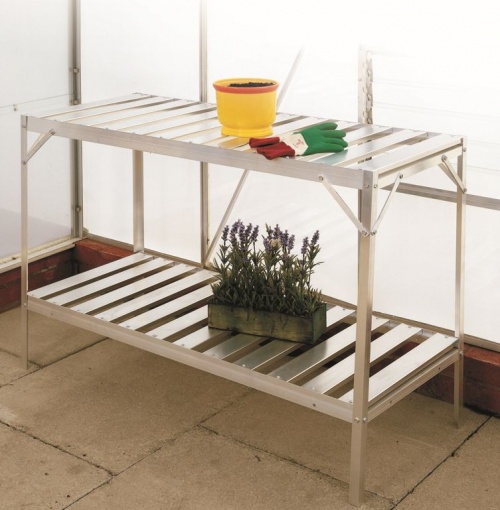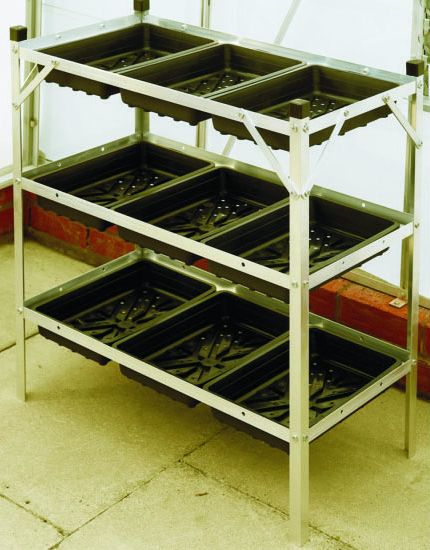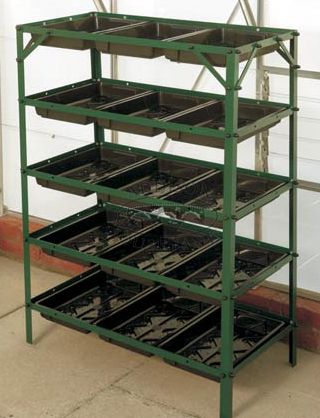Aluminium Greenhouse Staging
Staging is an essential for your greenhouse, you will almost certainly need a bench to work on and it will need to be well made so as to take a little weight. Greenhouse shelving also allows you to store everything easily inside.We supply aluminium Elite and Halls staging along with a range of potting benches and seed tray stands which are made from maintenance free aluminium which will never rust, also a selection of good quality wooden greenhouse benches which are extremely sturdy and attractive. All the aluminium or wooden staging we supply are free standing so can be moved where you wish and will fit any greenhouse.
How to Choose the Best Greenhouse Staging
There’s a lot to consider when you set up a new greenhouse in your garden. You need to think about factors such as shade, shelter, warmth and ventilation. It is also important to consider the materials that you use carefully and how much space you have. By far, one of the most important decisions you will make is your choice of greenhouse staging. The staging you choose will depend on the use of your greenhouse. What type of plants are you growing? What environment do you want?
You’ll need at least one bench to put your pots, plants and flowers on. It needs to be sturdy and well made too so that it can hold the weight. If you’re looking into some larger and heavy pots options when growing your plants, this is crucial. Some benches and staging are not designed to hold heavier weights so you’ll need to consider alternatives.
Setting up the staging, you do want to look at how effective the environment is. You should avoid restricting movement in the greenhouse because this will make it feel cramped. Remember, this isn’t just a place you can use to grow your plants. It could also be an excellent space for a nice cup of tea if you have enough room. Let’s look at some of the staging options that you can consider.
Choosing How Many Tiers
You need to think about how many levels you want for your greenhouse staging. Some people will settle for one level for their plants. It could be the best choice if you only have a few plants in your greenhouse. It will provide the ideal height from the ground for your plants to gain the most sunlight and warmth. Alternatively, you can consider using two or three tier staging. If you have a small greenhouse, you can make the most out of the limited space. In larger greenhouses, you can spread your plants out more so you can use fewer levels.
Be aware that more tiers could make the staging that you use unstable. At the point of four or more levels, you may find the shelves shake when you touch them. They will hold as long as the plants on top of them are not too large. But you may want to be careful with how much weight you put on some of the higher levels.
The best choice for an average greenhouse would be two tiers.
Selecting The Right Material
Once you have decided how many tiers to use, you can think about different build choices. For smaller potted plants, you should consider aluminium greenhouse staging. Since it is quite light, it’s easy to setup and take down. For heavier plants, you will want to pick something a little stronger. Especially if you are using large, bulky apparatus such as heaters.
You always need to be careful when choosing different staging. Aluminium staging should still be strong enough to hold heavier potted plants. Remember, when potted plants are wet, their weight increases. After you have watered the plants inferior staging could collapse due to the extra weight.
For heavier plants, you could choose a strengthened wood staging solution. This wooden staging will be sturdy enough to hold the largest plants. However, they can take up a lot of space in smaller greenhouses. Is the extra support necessary? It does tend to depend on what you are planning to grow.
You can get wooden benches that fold and are easy to put away when they are not in use. It’s an excellent choice if you plan on regularly changing the layout of your greenhouse. Although, benches like this are a usually a little more expensive compared to aluminium staging. You might also find that they are harder to position in smaller spaces.
Many people also worry about how long wood will last before it starts to rot. In a greenhouse, the environment is regulated to maximise plant growth. This can have an adverse impact on the wooden staging. If you do buy a timber staging, make sure it has been treated with rot resistant chemicals. If you do this, you won’t have to worry about the wood growing weaker after just a few years due to rot.
Modular Staging
Think about how much space you want each plant to have. As we explained, if you want the most amount of space, you should choose one tier greenhouse staging. But you can also get modular staging to separate different types of plants or separate pots into individual areas. You can pick the number of units based on how many plants you have. Or, alternatively, you can have a single wide space on each tier for all your plants. It depends on how you want your greenhouse laid out and what you’re growing. Some plants are more likely to develop with the maximum amount of space.
Different Styles
When selecting your greenhouse staging, you can choose from numerous different styles. For instance, you can purchase potting benches. These benches have deeper shelves compared to conventional staging. That makes them perfect for composting, helping ensure that your plants reach their full potential. You can buy these with one or two tiers depending on how many plants you have. They also come in a wide variety of different sizes, so you can choose which one fits your greenhouse. Remember, size is an important choice for practicality. If you are setting up near the door, you need to make sure that the staging doesn’t jut out. Otherwise, you might bump into it walking in the greenhouse, and that could cause a big mess.
You may need seed trays for your greenhouse as well. Before you put your plants in pots, let them seed naturally, in the soil and compost first. Seed trays can be purchased with multiple tiers, making them a real space saver. By their nature, seed trays don’t require much vertical space at all. Therefore they won’t take up a large area and will fit into any greenhouse.
Unique Options
You may also want to get greenhouse staging that is height adjustable. You don’t want to constantly be standing on your tiptoes or bending down to look after your plants. You can set the staging at chair height or just above your chest. It will also allow you to adjust the shelves to make sure plants get the most amount of light throughout the day.
Colours And Shades
You might want to consider the different shades and colours that you use for your greenhouse staging. Don’t forget that lighter and brighter colours naturally deflect light. If you don’t want your staging to get too hot, make sure you use bright, aluminium staging. If you want the extra heat, you can paint your staging a darker colour. Again, this depends on what type of plants you are growing and how much heat they need. If you’re growing tropical plants in the UK, you’re going to need all the heat you can get. You will probably even need to use electric heaters in your greenhouse. A greenhouse bench makes it easy to work in your greenhouse.
DIY Staging
If you don’t want to purchase your greenhouse staging, you can choose to DIY. Many gardeners build their staging, usually because they have special needs for their plants. For instance, if you want a heated sand bed, typical seed staging is not going to be able to take that kind of weight. Therefore, creating one yourself might be the best option. Again, make sure you build out of a durable material such as hardwood to ensure the staging holds.
Altering Your Staging
You may find that you need to change your shelving around, based on the season. For instance, in the winter, potted plants are going to require more warmth. If you have a lean to greenhouse, it’s best to put the staging against the side that is leaning on the wall of the garage or shed. If you don’t have a lean to greenhouse, you may want to move your staging to the south wall. Aluminium Staging is lighter and therefore might be a better choice because it's easier to move.
As you can see, there are plenty of different things to consider when choosing your staging. The main issue is always going to be weight. You need to be able to guarantee that your shelves can support all your plants. If you understand all the staging options, you’ll be able to keep your greenhouse neat, tidy and the perfect place for your plants.
Greenhouse Shelving
You'll almost certainly need some type of greenhouse shelving, staging or work bench for your new greenhouse or to add to your existing kit. You could spend a small or perhaps a large fortune in the quest for the ultimate accessories for your growing endeavours, so it's prudent to review all the options first and choose your essential kit before you move onto enhancements.
Greenhouse Staging. A work bench is essential for every greenhouse, but which one is right for you? Staging tends to come in three main types:
- Slatted staging - as its name suggests is slatted. You can also get slatted greenhouse shelving too. Lightweight and economical, it's the most popular option. The slatted design allows air to pass through the gaps and also enables free drainage. This ergonomic design ensures good ventilation, which is vital to keep the greenhouse cool on hot days, while the combination of good drainage and air flow creates the ideal conditions to keep pests and disease in check.
- Solid Staging - with a solid surface and often designed as a tray. Can be lined with gravel and perfect for keeping moist to suit particular plants.
- Plunge Staging - this also has a tray, but usually around 9inches deep, which can be filled with sand. Commonly used for growing alpines, this type of staging helps to replicate the natural growing conditions of alpines, where their roots are kept cool. The pots can be completely submerged in the sand if necessary.
Greenhouse Shelving - often slatted, for the reasons mentioned earlier, is usually erected above the staging and often used for germinating seeds. In this position closer to the roof of the greenhouse, the air is warmer, so perfect for the cultivation of seeds. It comes in different widths, but most can accommodate a standard seed tray at 34cm. Also handy for storing essentials bits and bobs in the greenhouse.
Seed Tray Stands - a frame designed to specifically hold seed trays in a confined space.
Greenhouse shelving, staging and seed tray stands are usually available in aluminium or timber or a combination of the two. When you do your research, ensure that the products you consider are strong and capable of supporting the weight of your pots and plants, especially when heavily-laden with water. Also make sure the materials are water-resistant and will stand up to everyday wear and tear. These days it's possible to get maintenance-free aluminium, which will never rust - a real advantage in the modern greenhouses of today!

.jpg)

